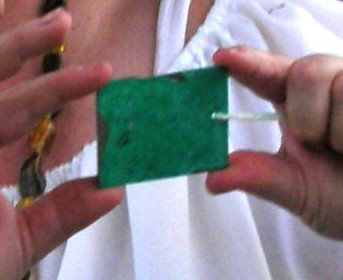
I first decided to study fish traps a few years ago. They are an integral part of the medieval cycle of fishing life. I was thrilled to see that they were on the competition schedule for Beltane. Technical Science: Mode or recreation of fishing impliments, such as fishing nets, fish spears or fish hooks. I decided traps are included.
I know about fish traps because we used them up until oh.. a year ago. I have eaten trapped fish most of my life. Crawdad traps are very much like the old fish traps I have decided to make. I know the design and I know how to bait it. If I get my fishing license, I could go do it. Hee. If. So, time for research.
These images were found at http://www.le.ac.uk/ulas/annualreports/ar99-00/hemington/hemington.html

Perhaps the most amazing discovery was a large wicker fish trap positioned at the apex. The trap was a cone-shaped basket over 2m long with two internal funnels (non-return valves), the size and arrangement suggesting that it was a silver eel trap. Fragments of another similar basket were found nearby lying on top of the weir.
They have excavated a fish weir which was a medieval structure designed to create a fishing area. It was about 75 yards long and created an artificial environment out of rocks and wattle. Medieval fisheries were a huge economic concern because of the amount of fasting days.
Wikipedia says: The Magna Carta includes a clause requiring that they be removed:
- All fish-weirs shall be removed from the Thames, the Medway, and throughout the whole of England, except on the sea coast.[18]
Basket weir fish traps were widely used in ancient times. They are shown in medieval illustrations and surviving examples have been found. Basket weirs are about 2 m long and comprise two wicker cones, one inside the other -- easy to get into and hard to get out.[19]
That isn't really true. They aren't wicker cones. It is really a valve inside a cone. But two cones inside each other is easier for some people to grasp. Regia.org has the *best* stuff because they care about medieval things.
It is likely that the trap was flat bottomed to allow it to lie on the river or sea bed without rolling with the current or tide. For eels it would need to be baited with a dead fish, this would attract the carnivorous eel into the funnel and once inside, they would find it difficult to escape. Single chambered traps may also have been used by the early medieval fisherman; these would have been something akin to the salmon putchers used earlier this century in Scotland and on the Severn River. The main advantage of these traps was that smaller fish could be caught, there was little danger of the fish swimming away from them as in the case with a net and they were relatively easy to maintain.
The traps themselves would be made from willow 'withies' that had been cultivated for at least three years. Today there are withy beds in the Southwest that produce willow withies in white, buff and brown. White withies are produced by stripping the bark away, the buff has been boiled with its bark on and then the bark then removed and the browns are the withies complete with bark. In the early medieval period the majority of the basket work was functional and there was no need to add extra work to the making of fish traps and baskets: brown withies would have been the most common. To weave the withies they would need to be soaked so as to make them pliable, they would need to be left to soak overnight to enable the surface water to penetrate to the pith of each withy.
by stripping the bark away, the buff has been boiled with its bark on and then the bark then removed and the browns are the withies complete with bark. In the early medieval period the majority of the basket work was functional and there was no need to add extra work to the making of fish traps and baskets: brown withies would have been the most common. To weave the withies they would need to be soaked so as to make them pliable, they would need to be left to soak overnight to enable the surface water to penetrate to the pith of each withy.
Ha! My laurel taught me this withy stuff. I am also downloading the Rule of St. Benedict so that I can see if he really reflects on this stuff.
Dark Age fish-traps
The number of early medieval fish-traps known in Britain is increasing. In Essex, a series of large, timber fish-traps around the coastline were long regarded as medieval, but two have now produced mid-Saxon radiocarbon dates of the 7th–9th centuries. The traps are in the Blackwater Estuary and near Bradwell-on-Sea.
Meanwhile, up the Thames in London, a mid-Saxon ‘wharf’ originally thought to be part of King Offa’s palace at Chelsea, and given wide national publicity last year (see BA, September), has on further examination been re-interpreted – as yet another Saxon fish-trap.
Essex Archaeology, an annual round-up of archaeological news from Essex, is now available free from the county council’s archaeology section (send an A4 SAE). From British Archeology: Issue 31 in February 1998. I need to get that.
